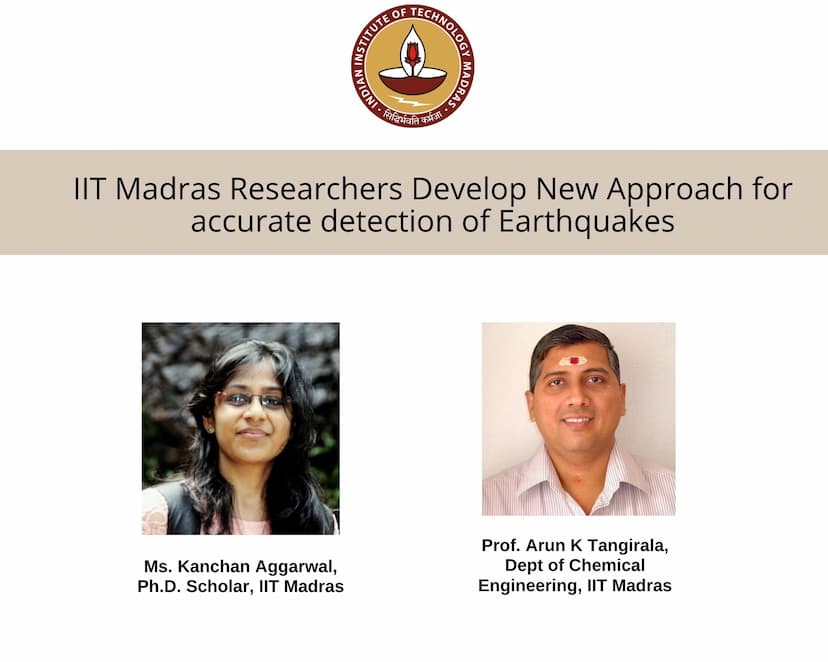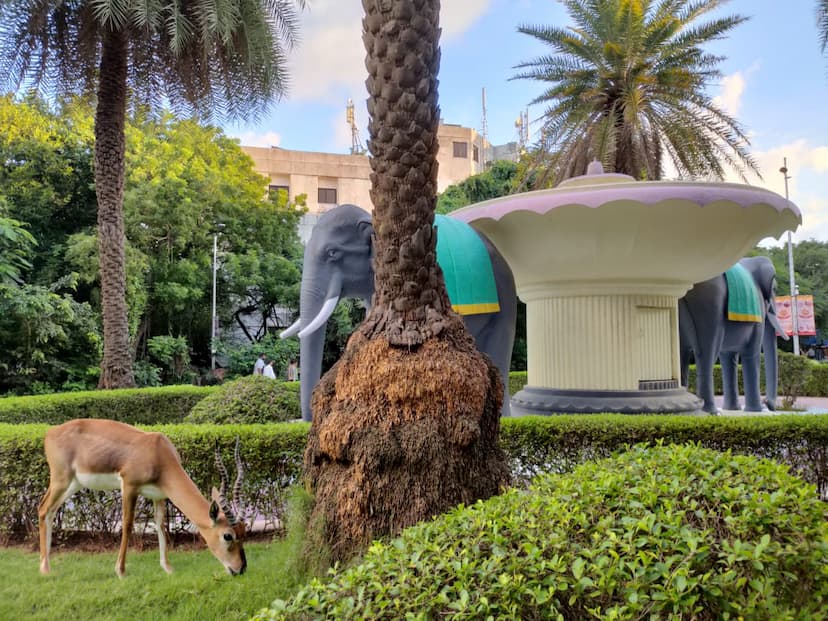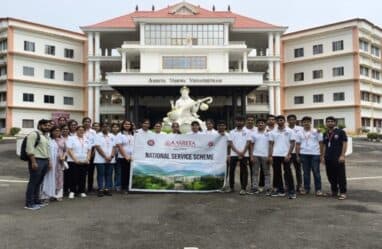IIT Madras researchers develop great new approach

IIT Madras researchers have developed a new approach for accurate detection of earthquakes. The proposed solution results in accurate detection and picking of the first waves in earthquake signals, which provide a small lead time and enable measures to save lives.
This research was undertaken by Ms. Kanchan Aggarwal (First Author), PhD Scholar, IIT Madras, under the guidance of Professor Arun K Tangirala, Department of Chemical Engineering, IIT Madras.
The findings of their research were published in the reputed peer-reviewed open access scientific journal PLOS ONE.


The research was partially funded by Board of Research in Nuclear Sciences, an advisory body of the Department of Atomic Energy.
An estimate of accurate time of arrival of non-destructive waves of earthquakes would not only help in developing a robust Early Warning System but also gives a lead time of approximately 30 seconds to 2 minutes (range may vary primarily depending on the distance of epicentre location from the monitoring site or plant) till the destructive surface waves hit the ground.
Sources from IIT Madras further say this lead time, though appearing small, is sufficient to shut down the nuclear reactors, transportation such as metro and to park the elevators in high rise building at the nearest floor, among numerous other measures that can save countless lives.

Also read ‘DRDO chairman to be chief guest for NIT Andhra Pradesh convocation‘
Highlighting the practical applications of the research and how it can be taken to the field, Professor Arun K. Tangirala of IIT Madras said, the proposed framework is not necessarily limited to the detection of seismic events but is generic and can be used for fault detection and isolation in other domains as well.
Furthermore, the framework can incorporate any predictive models including the Machine Learning and Deep Learning models, which will reduce the human intervention in the detection, said Professor Arun of IIT Madras.

Kanchan Aggarwal of IIT Madras said information of P-wave arrival is crucial in determining other source parameters of the event such as magnitude, depth and epicentre location.
Therefore, a solution to the P-wave detection problem that is robust, accurate and precise is essential in order to estimate the event details correctly and to reduce the damage caused by the earthquake or other triggered events, she said.
Read More – Top 20 private universities in India


The unique aspects of this novel solution approach as compared with the existing approaches are that it:
Ø Is commensurate with the noise characteristics resulting in minimal sensitivity to outliers or robust detection,
Ø Offers a more flexible frequency band selection, by decomposing both lower and higher frequencies in each level, resulting in accurate detection, and
Ø It allows the user to discard the noise in undesired time-frequency bands resulting in improved SNR. Thereby resulting in accurate picking of P-wave onset.
This work proposes a novel real-time automatic P-wave detector and picker in the prediction framework with a time-frequency localization feature, say sources from IIT Madras.
The proposed solution approach is not necessarily limited to the detection of seismic events but is rather generic in that it can be used for fault detection in other domains as well.
Another positive offshoot of the proposed framework is that it facilitates P-wave reconstruction once it has been detected. This aspect has not been explored by peers.
The ground is continuously at unrest mainly due to waves in the ocean, changes in the earth’s crust, atmospheric variations and human activities. Seismic signals can be generated from either natural (earthquakes, volcanic eruptions, tsunami, etc) or man-made (heavy traffic, nuclear explosions, mining activities, etc) sources.

Seismograms are recordings of ground vibratory motion obtained from a seismometer. Analysis of these seismograms is vital to understanding earth’s activity and in setting up early warning systems for earthquakes, determining the source locations and detecting the source of other seismic events.
Detecting or predicting the damaging part of an earthquake holds great value in protecting lives and preventing loss of property.
IIT Madras students
IIT Madras students have registered an impressive performance in pre-placement this academic year with the offers increasing during 2021-22.
A robust summer internship process, which the Institute conducted completely in online mode, helped connect the Industry and students and drove up the Pre-Placement Offers (PPOs).
As many as 227 PPOs (as on 5th November 2021) have been made to IIT Madras students during the 2021-22 Academic Year as against 186 offers during the entire 2020-21 Academic Year.
The PPOs will continue to be made till the commencement of Phase I of campus placements, which is scheduled for 1 December 2021. A major factor behind this performance in PPOs is the strong internship programme of the institute.
This process facilitates students to intern in companies and leads to PPOs. The constant increase in PPOs is the result of excellent performance of students during their internships.

It also helps our students to learn more about the company, the roles that they may be offered and potential career prospects. PPOs are a natural outcome of this interaction that is a win-win for both companies and students, he said.
‘We are happy to note the continuing strong performance of our students in this regard and hope to extend this to Phase-I placements.’
Highlighting the importance of internships to Campus Placements in IIT Madras, Professor Sathyan Subbiah, Advisor (Internships), IIT Madras said the internship process transforms the student from class-room ready to real-world placement ready.
The internship office continues its intended role in this transformation by linking companies with students early on, giving them a chance to test each other, while also meeting curricular needs said Professor Sathyan Subbiah.
Shaped by curricular and extra-curricular experiences at IIT Madras, our students are excelling in their internships. This has given enough confidence in the companies leading to pre-placement offers, he said.
Read More – Top 20 universities in India
Sources from IIT Madras said the about 60 percent of PPOs during 2021-22 came from core engineering and R and D sectors. About 12 percent of PPOs were made from IT sector, about 23 percent PPOs are made from Analytics/Consulting/Finance sectors. FMCG companies made about 5 percent of PPOs.
S Vishnu Sharmaa now works with collegechalo.com in the news team. His work involves writing articles related to the education sector in India with a keen focus on higher education issues. Journalism has always been a passion for him. He has more than 10 years of enriching experience with various media organizations like Eenadu, Webdunia, News Today, Infodea. He also has a strong interest in writing about defence and railway related issues.






